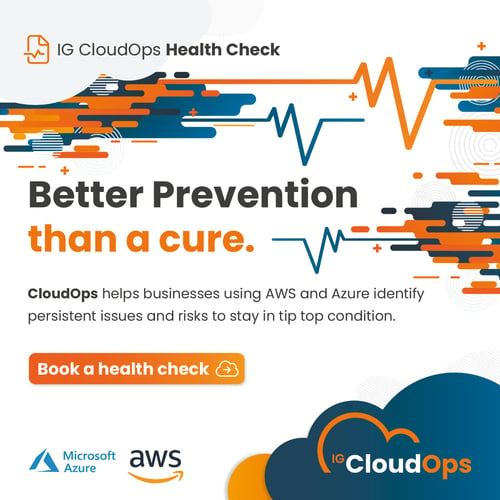5 Steps to a Pain Free Cloud in AWS & Azure
The cloud brings numerous benefits to businesses who choose to migrate their application or data hosting to a virtualised environment. However, the process of migrating to Azure or AWS can bring some challenges if proper planning is not undertaken.
IG CloudOps have helped businesses in multiple sectors migrate to the cloud and have developed a clear best practice process to minimise risk and simplify all steps.
Planning is Essential
Whether you are performing a selective migration of a small number of infrastructure elements to a new service or undertaking a full virtualisation, clear objectives and boundaries that define the scope of the project need to be set in advance.
You should agree the following in advance:
- What applications you want to run
- What data you want to store
- What the usage levels will be
Having this information in advance as the foundation of your comprehensive cloud migration plan is vitally important to avoid losing focus and control down the line.
An advantage of engaging an experienced consultant during the planning process is that they will be able to analyse your goals and determine how your expectations might be met. In some cases, they may recommend reducing the initial goals to prioritise what is required rather than what is desired. Common considerations at this stage may be application related or due to compliance requirements for data governance that preclude cloud hosting.
Analysing the Current Situation
At the start of the process, your consultant should conduct a full review of your existing technology.
By understanding what you currently have and how it is used is vital, as this informs the capacity you will need.
In the even that you were planning to recreate an existing physical server using virtual machines you need to ensure that the specification matches. You may also consider whether there are any bottlenecks with your current hardware that can be addressed by using a higher capacity machine for some functions to allow future growth. In some situations, a virtual network is specified at a lower specification which does not meet previous performance levels. This is often done to reduce costs and can be highly damaging.
During the period of analysis, it is important to review network and connectivity. Replacing on-premises physical hardware with cloud infrastructure in a remote data centre may mean that your external connection to the internet may need to be upgraded to cope with higher volumes of data.
A benefit of a deep analysis of your infrastructure is that it can also identify data and resources that are no longer required but is still using resource. Clearing out un-used legacy data can have 2 main benefits:
- Reducing costs through lower storage requirements
- Minimising the risk of incorrect information being accessed
Fully understanding your data will allow you to host the most commonly accessed information on priority servers to allow quicker access while older or less frequently used data is hosted on lower spec machines to reduce your overall spend level.
Fully Cost the Plan
In most cases, the migration to the cloud helps reduce reliance on legacy equipment, and in most cases, cloud infrastructure has lower costs than equivalent physical servers.
When planning the cost for your migration, you need to set a budget that is appropriate to your needs.
Over the lifetime of your subscription costs can vary depending on your usage and volume of data. Understanding your current usage levels is essential. If the right type of action and costing is not undertaking, it will often be the case that costs can exceed expectations.
Like for like, cloud costs will normally be lower than equivalent physical infrastructure, however if specifications for VMs are higher than the servers they replace, or consumption is unanticipated, overall costs may be higher.
Working with Experts
Strong consultant support is important during a major IT project, and never more so if the project involves the introduction of technology that your internal team are unfamiliar with. The earlier in the project that you get support, the higher the likelihood of success.
Our AWS And Azure consultants can advise you on the limits of the platform, and explain the different strengths and how they might help with your specific needs.
The major public cloud providers offer similar models with closely related benefits and costs and a range of Virtual Machines that can be defined to your needs. Where they differ most is in the level of support that is available and the additional services beyond infrastructure that they offer.
Choosing a service partner who is established and stable and has experience of working with different cloud platforms is essential as their experience and knowledge can help keep you informed about what services offer the best fit for your needs.
Choosing a Partner You are Comfortable With
Implementation is the most stressful part of any major IT project. Planning can be time consuming, but if it is carried out properly, it reduces overall risk. The final migration is higher risk and needs testing to ensure that nothing is lost.
Migrating to the cloud is a long-term investment and not something that you will want to do frequently. Finding find a partner for your cloud services who you can work with long term means that you can have a more stable IT strategy. Choosing a company that understands your organisation and commercial goals that can provide a strong lead is important.
If you are in the process of planning a migration to Microsoft Azure or Amazon AWS, please contact a member of our team to find out more about how we work, and how we can deliver a cloud migration project that improves your business.
Featured articles
Budgeting for an Azure deployment is an entirely different concept to traditional IT systems, and those differences cause significant challenges for many organisations.
In this article, we’ll break down the key issues with Azure cost management, provide advice for controlling your spending, and offer suggestions to increase the return on your cloud investment.
How do I Gain a Clear View of Costs in AWS and Azure & Stop Getting Surprises?
Migrating mission-critical applications and business processes to the cloud is a complex challenge that comes with a great deal of uncertainty.
In this article, we explore key considerations, provide guidance for managing the associated risks, and help you understand how to succeed with your own cloud migration.









